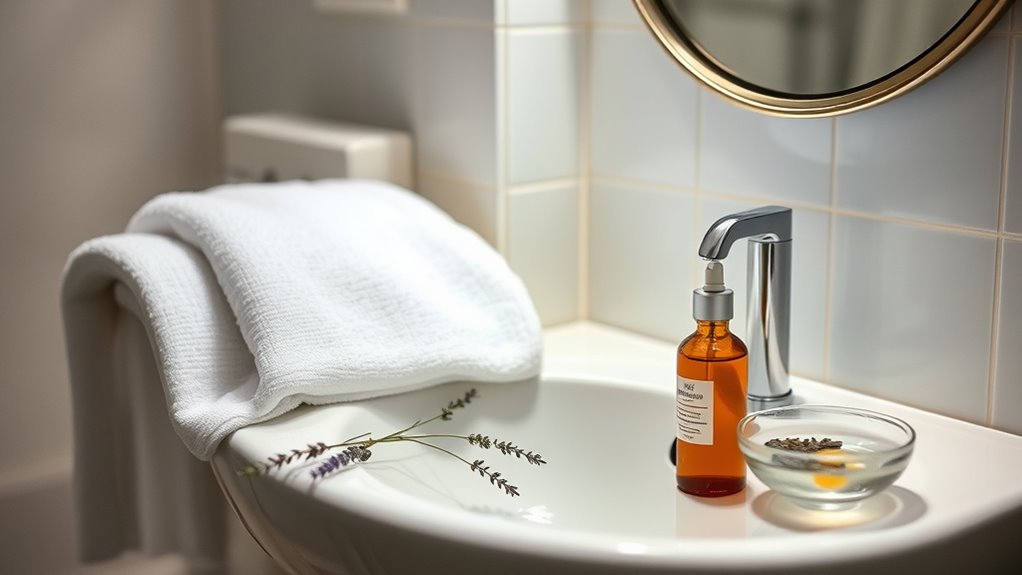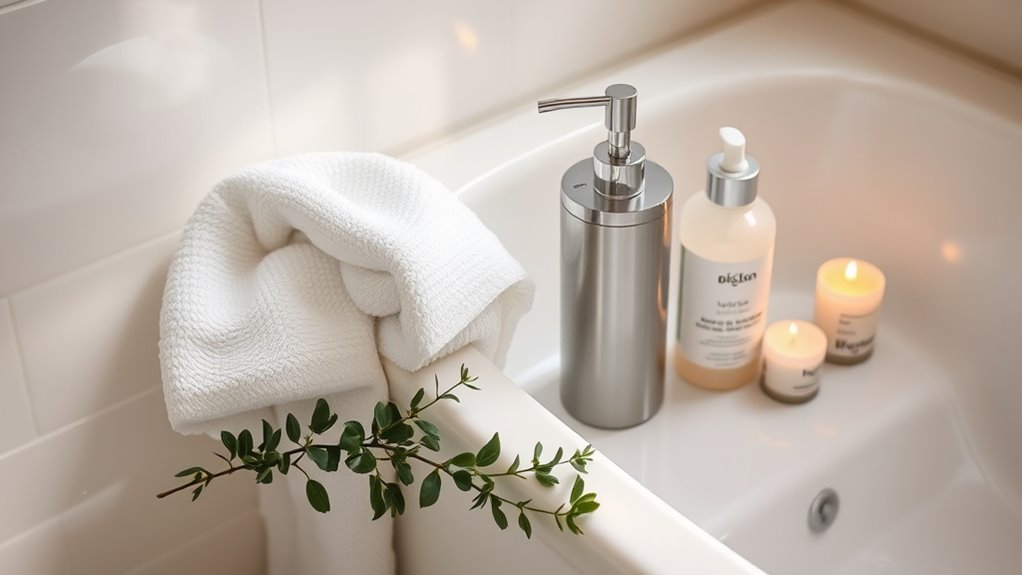After childbirth, maintaining hygiene and self-care is essential for your recovery. Start with proper hand washing to prevent infections, as it can greatly reduce neonatal mortality. Clean your perineum gently and use postpartum pads instead of tampons for at least six weeks. Take warm sitz baths, nourish your body with a balanced diet, and make sure you get enough rest. Address your emotional well-being by seeking support and sharing your feelings, which can lead to a smoother recovery journey ahead.
Key Takeaways
- Practice proper hand hygiene by washing hands before and after patient contact to prevent infections postpartum.
- Clean the perineum daily with warm water and avoid perfumed products to prevent irritation and infection.
- Use postpartum pads for heavy bleeding, changing them every four hours, and avoid tampons for at least six weeks.
- Limit bathtub immersion for the first six weeks; opt for warm sitz baths to promote healing and comfort.
- Prioritize mental health by communicating feelings openly, seeking support, and monitoring for signs of postpartum depression.
Importance of Hand Washing

While you may not always think about it, hand washing plays an essential role in preventing infections after childbirth. Ignoring this simple practice can lead to severe consequences, contributing to 30,000 maternal and 400,000 newborn deaths globally each year.
By washing hands, birth attendants can reduce neonatal mortality by about 25%. It’s vital to wash your hands at key moments: before touching a patient, before any aseptic procedures, after exposure to bodily fluids, and after interacting with patients or their surroundings.
Despite its importance, many healthcare settings struggle with low compliance rates for hand hygiene. By prioritizing hand washing, you can greatly lower infection risks for both you and your newborn, ensuring a healthier start to life.
Proper Perineum Care

After ensuring proper hand hygiene, it’s time to focus on perineum care, which is essential for your recovery following childbirth.
Start by showering or bathing daily, using warm water to clean the area gently, especially after using the toilet.
Pat the perineum dry to avoid irritation, and steer clear of perfumed soaps or wipes. A peri-bottle can be your best friend for gentle cleaning.
For pain and swelling, consider ice therapy and supportive underwear.
Keep an eye out for signs of infection, and remember to stay hydrated to aid healing.
Allow some air circulation by exposing the area when possible, and consult your healthcare provider if you notice any unusual symptoms during your recovery.
Safe Use of Sanitary Products

Choosing the right sanitary products after childbirth is essential for your comfort and recovery.
Postpartum pads are specifically designed for the heavy bleeding you’ll experience, especially in the first few days. These pads, made from soft materials, reduce irritation and provide necessary comfort during healing. You can find various sizes and absorbency levels to match your flow, with options like extra-long pads and those with wings for added protection.
Postpartum pads are designed for heavy bleeding, offering comfort and protection with various sizes and absorbency levels.
Remember to change your pad every four hours to maintain cleanliness and prevent infection. Avoid using tampons for at least six weeks postpartum.
Alternatives like period underwear or adult diapers can also offer discreet options for managing leakage during this recovery period.
Prioritize your hygiene for a smoother healing process.
Effective Bathing Techniques

Maintaining proper hygiene after childbirth goes beyond selecting the right sanitary products; bathing techniques play an essential role in your recovery.
For the first four to six weeks after a vaginal birth, avoid full immersion in bathtubs to minimize infection risks. Limit your baths to 30 minutes, using warm—not hot—water for comfort.
A sitz bath can effectively promote healing and relieve discomfort; fill it with 2-3 inches of warm water and consider adding Epsom salts for extra relief.
After bathing, gently pat the area dry to prevent irritation. Always clean your bathing equipment after use and store it properly.
If you notice increased pain or unusual swelling, contact your healthcare provider for guidance.
Nutrition for Recovery

Nutrition plays an essential role in your recovery after childbirth, as the right foods can help heal your body and restore your energy levels.
Focus on a balanced diet that includes fruits, vegetables, whole grains, lean proteins, and healthy fats. Adequate protein is vital for muscle repair, while iron and calcium support your energy and bone health. Don’t forget vitamins C and D for immune function and tissue repair.
Eating nutrient-dense snacks throughout the day can maintain your energy levels. If you’re breastfeeding, you’ll need an extra 300-400 calories daily, so consider incorporating high-protein snacks like Greek yogurt. Including nutrient-dense foods can also support your overall health and recovery.
Meal planning ahead of time can ease stress and guarantee you have healthy options ready when you need them.
Staying Hydrated

Staying hydrated after childbirth is essential for your recovery and overall well-being. Proper hydration supports tissue healing, especially if you’d a C-section.
Aim for at least 3 liters of water daily, particularly if you’re breastfeeding, as breast milk is about 90% water. Keep a reusable water bottle nearby to remind yourself to drink regularly. Incorporate hydrating fruits and vegetables like peaches and cucumbers into your diet.
Avoid high-sugar and caffeinated beverages, which can lead to dehydration. Staying hydrated helps prevent fatigue, headaches, and digestive issues like constipation.
The Role of Rest in Healing

While you might feel the urge to jump back into your routine after childbirth, prioritizing rest is essential for your recovery.
Rest greatly reduces the risk of postpartum bleeding and complications, allowing your uterus to heal properly. By avoiding excessive physical strain, you can minimize pain and discomfort, while also protecting your pelvic floor health.
This downtime helps prevent hemorrhoids from becoming more painful and supports a quicker recovery from any birth-related injuries or surgeries.
Remember, rest isn’t just about physical healing; it’s also about creating a safe space to bond with your baby.
Embrace this time to recover fully, ensuring you’re ready for the challenges of motherhood ahead.
Addressing Emotional Well-being

Emotional well-being after childbirth is crucial, as it greatly impacts your ability to care for your newborn. You might experience emotional fluctuations, ranging from joy to anxiety, which are common during this time.
About 80% of new parents face the “baby blues,” typically resolving within two weeks. However, around 15% may develop postpartum depression, affecting your emotional state for up to a year.
It’s essential to nurture a support network; friends and family can provide understanding and help. Engaging in self-care activities like mindfulness or journaling enhances emotional regulation. Additionally, building a support network is vital for healing from any emotional challenges you may encounter in this period.
Overall Self-Care Practices

After addressing your emotional well-being, it’s important to focus on overall self-care practices that support your recovery and help you thrive as a new parent.
Prioritize rest by sleeping when your baby sleeps, as this is vital for physical healing and energy. Maintain a balanced diet rich in whole foods and stay hydrated, especially if you’re breastfeeding.
Gentle exercises like walking or yoga can boost your mood, but consult your doctor before resuming strenuous activities. Practice good hygiene by keeping your perineum clean and washing your hands frequently.
Finally, manage any postpartum challenges, such as hemorrhoid care or C-section recovery, to guarantee your body heals properly. Taking care of yourself sets a strong foundation for both you and your baby.
Engaging With Support Systems

Engaging with support systems is essential for managing the challenges of new motherhood. Connecting with family, friends, and healthcare providers can greatly improve your mental health.
Consider joining online support groups if local resources are limited; they offer a sense of community and help reduce feelings of isolation. Traditional face-to-face groups provide emotional support and practical advice, making it easier to share your experiences.
Don’t hesitate to communicate openly with your healthcare provider—screening for postpartum depression can lead to early intervention and better outcomes for you and your baby.
Frequently Asked Questions
How Long Should I Avoid Tampons Postpartum?
You should avoid tampons for at least six weeks postpartum.
This waiting period allows your body to heal properly and reduces the risk of infection.
During this time, you can use pads or other alternatives to manage bleeding.
Pay attention to your body’s signals, and consult your healthcare provider for personalized advice based on your recovery.
Once you get the green light, you can gradually reintroduce tampons if you feel comfortable.
Can I Use Scented Products for Vaginal Care?
You should avoid using scented products for vaginal care. They can disrupt your natural pH balance and lead to infections.
Instead of masking odors, focus on understanding the underlying causes. Opt for unscented, chemical-free alternatives to minimize irritation.
Natural ingredients, like aloe vera, are gentler and safer. Prioritizing your vaginal health means choosing products that support it, so stick to those that won’t cause discomfort or complications.
What Signs Indicate an Infection After Childbirth?
After childbirth, spotting an infection can feel like searching for a needle in a haystack.
You should watch for a fever over 100.4°F, worsening abdominal or pelvic pain, redness or discharge around any surgical sites, foul-smelling vaginal discharge, and heavy bleeding with large clots.
If you notice any of these signs, don’t hesitate to contact your healthcare provider. Early detection can make all the difference in your recovery.
How Can I Manage Postpartum Hair Loss?
To manage postpartum hair loss, focus on a balanced diet rich in vitamins and minerals. Incorporate protein, omega-3 fatty acids, and iron into your meals.
Use gentle hair care practices, like sulfate-free shampoo and avoiding heat styling. Regular scalp massages with natural oils can improve circulation.
Limit tight hairstyles and vigorous brushing to prevent breakage. If concerns persist, consult your healthcare provider for personalized treatment options.
When Can I Resume Sexual Activity After Childbirth?
Resuming sexual activity after childbirth can feel like waiting for a meteor to land!
Typically, you’re looking at around 4 to 6 weeks postpartum, but listen to your body.
If you’re still bleeding or not feeling quite yourself, it’s okay to wait longer.
Emotional readiness matters just as much as physical healing.
Always check in with your healthcare provider to verify you’re cleared and ready to dive back into intimacy.
Conclusion
As you begin this new journey of motherhood, remember that caring for yourself is just as essential as caring for your baby. Just like the phoenix rises anew from the ashes, your strength and resilience will shine through with proper hygiene and self-care. Embrace the support around you, nourish your body, and take time to rest. By prioritizing your well-being, you’ll not only heal but also thrive in this beautiful chapter of your life.









